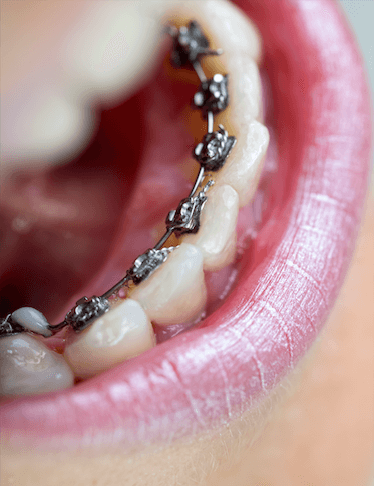
If you or your child has crooked teeth and need braces, you are not alone – more than four million people in the United States have braces. About one-fourth of those wearing braces are adults. There are several types one can get: lingual braces, traditional, or even clear braces.
While braces do a good job of making your teeth look and function nicely, many people are unhappy with the way traditional braces look. Traditional braces typically have a lot of metal brackets, wires and rubber bands that sit on the outside of the teeth, where they can be seen when you smile, talk, laugh and eat.
Fortunately, Dr. Natalia Valderrama, our orthodontist at Valderrama Orthodontics offers lingual braces. These technically advanced braces are virtually invisible. This is very important for anyone who is concerned with how he or she appears, such as business people, teachers, medical professionals, and other individuals. Anyone who works in front of a camera may opt for lingual braces. People who play wind instruments or engage in certain sports, such as contact sports, may prefer lingual braces over traditional braces. While it is not surprising to see teenagers with traditional braces, teenagers can be especially sensitive about their appearance.
About Lingual Braces
Traditional metal braces go on the front of teeth, where they are easily seen. Lingual braces, by comparison, go on the back of the teeth where they cannot be seen.
Not all orthodontists offer lingual braces; only dentists who have taken specific continuing education courses have the know-how to use the equipment required to place lingual braces. Patients should seek out the care of orthodontists with the training and experience to place lingual braces correctly.
Dr. Valderrama not only has that training but she is also the only Orthodontist in Brevard County with actual existing cases and more than 10 years of experience in lingual braces.
Are Lingual Braces Right for You?
Lingual braces are not right for everyone. These braces do not work well for children or for adults with exceptionally small teeth, as short teeth do not provide enough room to glue the braces on the backside of the tooth. People with excessive bite problems, such as severe overbite, underbite and crossbite, may not be able to have lingual braces.
Some people have trouble adjusting to lingual braces because the position of the braces affects the tongue. At first, some patients may have trouble swallowing without thrusting their tongue against their teeth. The force of the tongue pushing against the teeth during swallowing can even lead to more dental issues. Fortunately, you can learn how to swallow without thrusting your tongue by touching your teeth together lightly and then your palate or the roof of your mouth before swallowing.
Other patients may have trouble speaking clearly for the first few weeks after getting lingual braces. To overcome this, try over-enunciating your words.
Caring for Your Lingual Braces
Keeping your teeth clean is important, no matter which type of teeth straightening approaches you use. Removing food particles and bacteria from the surface of teeth and braces is important in preventing tooth decay and gum disease.
Because your lingual braces are hiding behind your teeth, you may forget they are there when you brush. The placement of lingual braces can also make harder to check whether you have brushed away all the food particles. If you have trouble cleaning your lingual braces, try using a toothbrush with a narrow tip, which can make it easier to clean the back surface of your teeth.
To keep your teeth and your lingual braces in top condition, brush after every meal. Be sure to brush each tooth at its gum line, and both above and below the brackets of your sublingual braces. Also, usually while in lingual braces, more frequent appointments for cleanings with your general dentist are required. Typically every 3 months a cleaning is needed to keep lingual braces clean.
For more information about lingual braces, and to find out if lingual braces are right for you, speak with an orthodontist with the training and experience in these special braces. You might be glad to learn that you can get straighter teeth without the embarrassing appearance of metal brackets and wires of traditional braces. Call Dr. Natalia Valderrama at Valderrama Orthodontics in Suntree, Melbourne today. 321.425.5050 or visit us at www.valderramaortho.com to learn more.


Let's Get Social